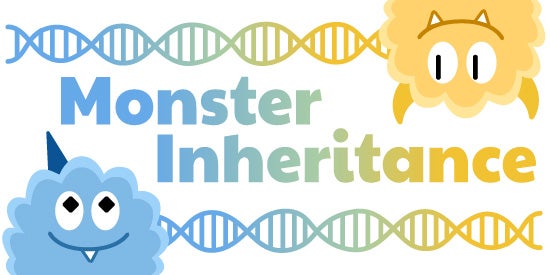
Illustrated by: Sabine Deviche
An Introduction to Genetics and Inheritance
Have you ever wondered why kids often look like their parents? Why puppies and kittens from the same parents look similar, but not the same? Or maybe you are just wondering why some apples are sour and some are sweet. These are all due to inheritance, which is how info is passed from parents to kids.

But what does that look like, and how can we see something like that?
With the help of some monsters, of course!
You will learn about inheritance by playing with monsters. Using this lesson, you’ll learn:
- What inheritance is
- Why children might look different from their parents and their siblings
- How information is passed from parent to kid
What You Need
- One copy of the Monster Mixer Activity per pair of students
- PowerPoint presentation (your teacher has this)
- One coin of any kind, or one 6 sided die
- Whiteboard (or a piece of paper and a pen/pencil)
If you are playing Monster Maker online, you will also need:
- Access to a computer
If you are doing a paper version of Monster Maker, you will also need:
- Monster Maker worksheet
- Colored pencils, crayons, or markers
Procedure
ENGAGE

1. Your teacher will be guiding the class through a presentation. Follow along with the slides and think about the questions. Talk about them with your table.
2. Consider the scenario with Farmer Joe and his peas. If the short and tall peas are crossed (bred) together, how tall will the peas he makes be? Why? Discuss this with your table.
3. Discuss your thoughts with the class. Did everyone agree with you?
EXPLORE
4. Your teacher will pass out the Monster Mixer worksheet. Complete the worksheet with a partner unless your teacher tells you otherwise.
5. What is similar between Tombly and Tangely? What is different?
6. Think about what their baby will look like. What will their baby look like if it is a blend of Tombly and Tangely? Are there other options? Does it look like Baby Tangerine was a blend? Does Baby Tangerine have any unique traits?
7. Talk with your partner about why you think Baby Gesundheit has two horns when neither of its parents do. Do you think it might be related to the story Galoo told about its horns?
EXPLAIN
8. As a class, discuss the activity. What did you learn about how traits are inherited?
9. Explain your theory as to why Baby Gesundheit was born with two horns. Did people have different theories than you and your partner did?
10. Discuss what Inherited and what Acquired mean. Work together as a class to predict whether traits are inherited or acquired. Your teacher will show you example traits on the slideshow.
11. Your teacher may have other steps to make sure you understand the lesson. Follow their instructions! If you have any questions, now is a great time to ask your teacher.
This might be a good spot to end for the day... check with your teacher!
ELABORATE
12. Watch the video your teacher shows you.
13. With the help of your teacher, think about how traits are able to be inherited. How is the information passed down from parent to child? How are DNA and proteins involved?
14. Your teacher will either pass out worksheets or you can click the image to play Monster Maker.
15. Decode the codons. Use the key at the bottom to reveal the instructions on how to build your monster! If you are working on paper, try to draw your monster! It’s okay if they look silly.
16. Everyone made different monsters. Show your monster off to the people at your table and talk about how you made them. What is this game similar to?
17. Participate in the discussion of traits and genetic information:
- What part of the game is similar to codons?
- What part of the game is similar to the bases?
- Do you think this game is similar to real life, or do you think it is different?
- How are traits passed from parents to kids?
EVALUATE
18. With your partner, use your white board/paper to write down the definitions of the following terms:
- Trait
- Inherited
- Acquired
- DNA
- Codon
19. After a few minutes, you and your partner will work with the other people at your table. Try to make your definitions even better.
Don’t forget to turn in any worksheets you might have completed.
When this activity was first designed, Emma Gerrard was a Barrett Honors undergraduate student at Arizona State University, where they were studying genetics. They designed the activity as part of their student thesis.
Read more about: Monster Inheritance
Bibliographic details:
- Article: Monster Inheritance
- Author(s): Emma Gerrard
- Publisher: Arizona State University School of Life Sciences Ask A Biologist
- Site name: ASU - Ask A Biologist
- Date published:
- Date accessed:
- Link: https://askabiologist.asu.edu/experiments/monster-inheritance
APA Style
Emma Gerrard. (). Monster Inheritance. ASU - Ask A Biologist. Retrieved from https://askabiologist.asu.edu/experiments/monster-inheritance
Chicago Manual of Style
Emma Gerrard. "Monster Inheritance". ASU - Ask A Biologist. . https://askabiologist.asu.edu/experiments/monster-inheritance
Emma Gerrard. "Monster Inheritance". ASU - Ask A Biologist. . ASU - Ask A Biologist, Web. https://askabiologist.asu.edu/experiments/monster-inheritance
MLA 2017 Style

In this lesson, with a few rolls of a die and a game and presentation, you will learn a bit about how traits are inherited.
Be Part of
Ask A Biologist
By volunteering, or simply sending us feedback on the site. Scientists, teachers, writers, illustrators, and translators are all important to the program. If you are interested in helping with the website we have a Volunteers page to get the process started.
